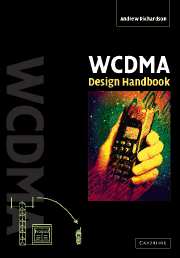Book contents
- Frontmatter
- Dedication
- Contents
- Preface
- Acknowledgements
- List of abbreviations
- 1 Introduction
- 2 WCDMA in a nutshell
- 3 Spreading codes and modulation
- 4 Physical layer
- 5 RF aspects
- 6 Chip rate processing functions
- 7 Symbol rate processing functions
- 8 Layer 2 - medium access control (MAC)
- 9 Layer 2 - RLC
- 10 PDCP and BMC protocols
- 11 Layer 3 - RRC
- 12 Measurements
- 13 NAS
- 14 Idle mode functions
- Appendix
- References
- Index
5 - RF aspects
Published online by Cambridge University Press: 05 October 2013
- Frontmatter
- Dedication
- Contents
- Preface
- Acknowledgements
- List of abbreviations
- 1 Introduction
- 2 WCDMA in a nutshell
- 3 Spreading codes and modulation
- 4 Physical layer
- 5 RF aspects
- 6 Chip rate processing functions
- 7 Symbol rate processing functions
- 8 Layer 2 - medium access control (MAC)
- 9 Layer 2 - RLC
- 10 PDCP and BMC protocols
- 11 Layer 3 - RRC
- 12 Measurements
- 13 NAS
- 14 Idle mode functions
- Appendix
- References
- Index
Summary
In this chapter we consider the RF aspects for the WCDMA transceiver. We focus on the FDD mode, starting with a review of the basic transmitter specifications for the UE and the Node B. Following this, we introduce some terminology and parameters that define the receiver characteristics. Then, we examine the receiver specifications themselves with some comments on the likely design targets for the receiver. In the final section, we review elements of an example design, taking the design issues for a UE transceiver as the reference.
Frequency issues
UMTS frequency bands
Table 5.1 illustrates the ‘current’ proposed bands for the deployment of the UMTS system. Band I is the ‘IMT-2000’ band, Band II is the US personal communication system (PCS) band, and Band III is the digital cellular network at 1800 MHz (DCS1800) band.
North American PCS bands
To understand the frequency allocations in the US PCS bands, it is useful to examine the band allocations for the US bands. Table 5.2 presents the US PCS bands. The ‘C block’ licences have been reauctioned to create a number of subbands as shown in the table. Figure 5.1 illustrates the band structure for the PCS bands, including the different band allocations for the ‘C block’.
- Type
- Chapter
- Information
- WCDMA Design Handbook , pp. 137 - 183Publisher: Cambridge University PressPrint publication year: 2005



